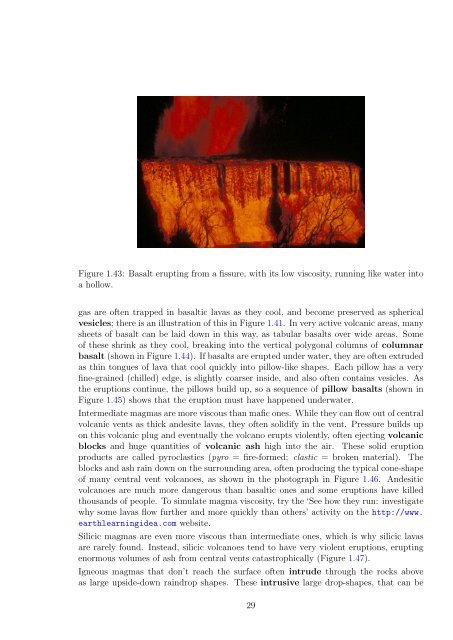The planet we live on: The beginnings of the Earth Sciences
The planet we live on: The beginnings of the Earth Sciences
The planet we live on: The beginnings of the Earth Sciences
- No tags were found...
You also want an ePaper? Increase the reach of your titles
YUMPU automatically turns print PDFs into web optimized ePapers that Google loves.
Figure 1.43: Basalt erupting from a fissure, with its low viscosity, running like water intoa hollow.gas are <strong>of</strong>ten trapped in basaltic lavas as <strong>the</strong>y cool, and become preserved as sphericalvesicles; <strong>the</strong>re is an illustrati<strong>on</strong> <strong>of</strong> this in Figure 1.41. In very active volcanic areas, manysheets <strong>of</strong> basalt can be laid down in this way, as tabular basalts over wide areas. Some<strong>of</strong> <strong>the</strong>se shrink as <strong>the</strong>y cool, breaking into <strong>the</strong> vertical polyg<strong>on</strong>al columns <strong>of</strong> columnarbasalt (shown in Figure 1.44). If basalts are erupted under water, <strong>the</strong>y are <strong>of</strong>ten extrudedas thin t<strong>on</strong>gues <strong>of</strong> lava that cool quickly into pillow-like shapes. Each pillow has a veryfine-grained (chilled) edge, is slightly coarser inside, and also <strong>of</strong>ten c<strong>on</strong>tains vesicles. As<strong>the</strong> erupti<strong>on</strong>s c<strong>on</strong>tinue, <strong>the</strong> pillows build up, so a sequence <strong>of</strong> pillow basalts (shown inFigure 1.45) shows that <strong>the</strong> erupti<strong>on</strong> must have happened underwater.Intermediate magmas are more viscous than mafic <strong>on</strong>es. While <strong>the</strong>y can flow out <strong>of</strong> centralvolcanic vents as thick andesite lavas, <strong>the</strong>y <strong>of</strong>ten solidify in <strong>the</strong> vent. Pressure builds up<strong>on</strong> this volcanic plug and eventually <strong>the</strong> volcano erupts violently, <strong>of</strong>ten ejecting volcanicblocks and huge quantities <strong>of</strong> volcanic ash high into <strong>the</strong> air. <str<strong>on</strong>g>The</str<strong>on</strong>g>se solid erupti<strong>on</strong>products are called pyroclastics (pyro = fire-formed; clastic = broken material). <str<strong>on</strong>g>The</str<strong>on</strong>g>blocks and ash rain down <strong>on</strong> <strong>the</strong> surrounding area, <strong>of</strong>ten producing <strong>the</strong> typical c<strong>on</strong>e-shape<strong>of</strong> many central vent volcanoes, as shown in <strong>the</strong> photograph in Figure 1.46. Andesiticvolcanoes are much more dangerous than basaltic <strong>on</strong>es and some erupti<strong>on</strong>s have killedthousands <strong>of</strong> people. To simulate magma viscosity, try <strong>the</strong> ‘See how <strong>the</strong>y run: investigatewhy some lavas flow fur<strong>the</strong>r and more quickly than o<strong>the</strong>rs’ activity <strong>on</strong> <strong>the</strong> http://www.earthlearningidea.com <str<strong>on</strong>g>we</str<strong>on</strong>g>bsite.Silicic magmas are even more viscous than intermediate <strong>on</strong>es, which is why silicic lavasare rarely found. Instead, silicic volcanoes tend to have very violent erupti<strong>on</strong>s, eruptingenormous volumes <strong>of</strong> ash from central vents catastrophically (Figure 1.47).Igneous magmas that d<strong>on</strong>’t reach <strong>the</strong> surface <strong>of</strong>ten intrude through <strong>the</strong> rocks aboveas large upside-down raindrop shapes. <str<strong>on</strong>g>The</str<strong>on</strong>g>se intrusive large drop-shapes, that can be29
















